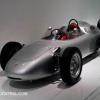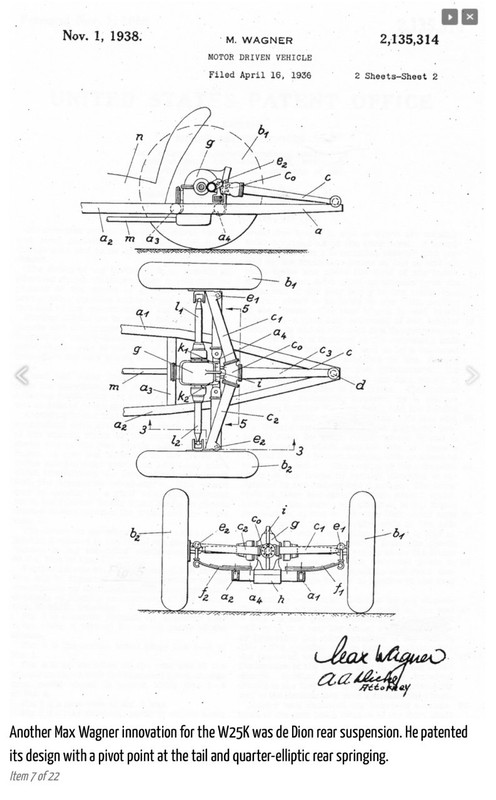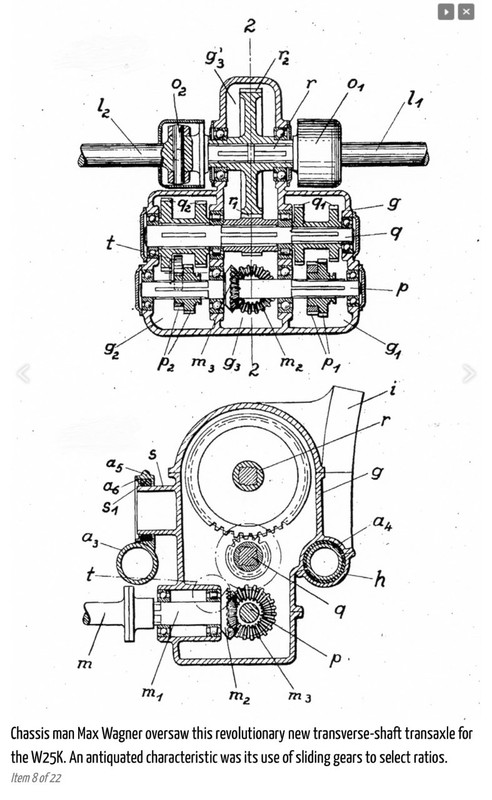
1936 Mercedes-Benz W25 - De Dion or swing-axle rear suspension?
#1

Posted 26 March 2024 - 11:15
However, following a discussion this morning on Facebook, I’ve been rechecking things. I’ve found one source (Mercedes-Benz Grand Prix Racing 1934-1955 by George Monkhouse) which says that the 1936 version of the W25 was fitted with De Dion rear suspension. A post in this earlier thread says that Karl Ludvigsen’s Quicksilver Century book, which I don’t have, also says De Dion.
So the question is: did the 1936 Mercedes-Benz W25 actually race with De Dion rear suspension, or was it only fitted as part of a test programme for the 1937 W125? If it did race with De Dion, how come so many sources got it wrong?
Advertisement
#2

Posted 26 March 2024 - 12:25
Hi, Tim.
My understanding is that yes, the 1936 W25 actually raced with De Dion rear suspension. It has often been said that the Mercedes W125 was the car that re-introduced the de Dion axle, but the 1936 Mercedes was in fact the first. The de Dion rear axle was retained for the W125 but mounted the other way with the center connected to a slot in the gearbox combining sideways rigidity with vertical movability, whilst the springs were replaced by torsion bars.
#3

Posted 26 March 2024 - 19:34
THe De Dion "tube" of the 1936 car was a pair of arms from each hub meeting at a point well behind the rear wheels. They could not be seen with the body work fitted, so most observers were not aware that there was anything different.
#4

Posted 26 March 2024 - 20:51
Günter Engelen's Mercedes-Benz Renn- und Sportwagen seit 1894 says that the De Dion axle was an integral part of the revamp for the 1936 W25 "kurz" (short), and that it was modified several times during the season, but doesn't show pictures of the assemble. He opines that the shortcomings of the car had mostly to do with the front axle, and that Uhlenhaut made a similar assessment after his initial test drive with the car after the German GP, also pointing out that the chassis was not stiff enough. All those things were addressed with the W125, with an improved version of De Dion axle, a new oval-tube frame and unequal-length wishbones for the front susension.
#5

Posted 27 March 2024 - 04:31
The first iteration of the W25 in 1935 was swing axle rear suspension.
For the 1936 season, to correct "erratic" rear grip the "wagen" was converted to an unusual "Y" shaped de Dion tube. For the last version the de Dion was "refined" with further locational mods.
First picture is an original drawing of the de Dion system with the three arms marked C are the tubing.
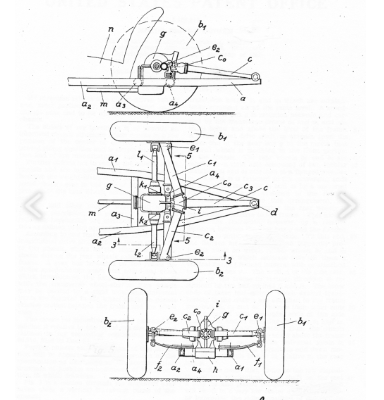
To make ot clearer (I hope) I have coloured those arms in.
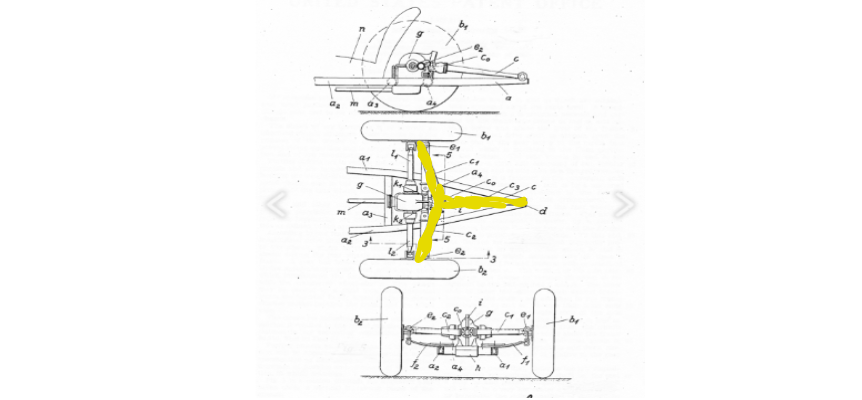
Cheers all
#6

Posted 27 March 2024 - 06:30
The 'Y' structure combines the de Dion tube with the locating medium...
Hence there are no conventional trailing arms, the drive is applied to the chassis at the point at the rear.
#7

Posted 27 March 2024 - 07:50
#8

Posted 27 March 2024 - 10:42
It's funny how some things stick in your mind, even after sixty years...
Motor Sport January 1964 published a letter which included: "...the Mercedes-Benz racing cars of 1938/39 followed Dr. Porsche's Auto-Unions in having de Dion rear suspension...". It was even more memorable because it came from the Marketing Manager of Mercedes-Benz (England) ltd.
#9

Posted 27 March 2024 - 10:51
#10

Posted 28 March 2024 - 04:45
https://mercedes-ben....xhtml?oid=6809
You are probably all familiar with Mercedes' online archive, if not click on the link above to go thru the history of the W25 to W125 year by year from 1934-1937. Great concise history.
Sadly, of 359 photographs not one is 'body off rear suspension' !
I've set aside Chris Nixon's 'Racing The Silver Arrows' my Easter is sorted. To be honest I'm not sure I read it cover to cover when I first bought it in the early 1990s.
m
#11

Posted 28 March 2024 - 04:54
The 1936 car was obviously very different to the earlier versions of the W25. I wonder why they didn’t give it a new ‘W’ number, as they did the following year with the W125.
I'm seriously no expert on these series cars, but I thought the W25K was the different model number?
#12

Posted 29 March 2024 - 09:49
I don’t think I’ve heard of the W25K designation except on the internet. However, it is used on the Golden Era site and that’s usually a good sign. Manufacturers of long ago didn’t always follow today’s logic of when to change model names; look only at the Maserati 250F and BRM Type 25, both of which changed significantly during their lives.
The 1936 engine was the E-Series, or ME25. They originally intended to use the DAB V12 and weight saving to accommodate that engine was a large part of the reason that the car was smaller than its predecessors. The engine turned out to be heavier than expected and the idea was abandoned. Uhlenhaut said that they could have built a DAB car to comply with the 750kg limit but it would have been too nose heavy to handle well.
the Mercedes-Benz website linked by Mark Bisset contains some interesting revelations, including that Varzi drove a Mercedes in 1935.
#13

Posted 31 March 2024 - 00:07
Guys,
Apropos the "W25K' designation. The website cited above, in the W25 1936 section reads: "...the frame, suspension and body of the W25 for 1936 had to meet the very highest requirements in order to ensure competitiveness. For this reason, the decision was made in Untürkheim to make the new W25 shorter, more compact and lighter, and to equip it with a new body and newly developed rear axle."
"In order to achieve the former, the previous wheelbase was shortened from 2715mm to 2505mm - which incidently led to the new internal designation of the car 'W 25 short'..."
The balance of the piece refers to the (six built) SWB W25's as "the short W 25", "the W 25 short", " W 25s short". The descriptor 'W25S' or 'W25K' is not used at all. To me W25K is completely acceptable but I am not at the uber-pedantic end of residents of this manor.
Mercedes' website names the car "Mercedes Benz Grand-Prix racing car W 25, 1936". As a scribbler there is a lot to be said for clarity and expediency, so after a description of the new 1936 W25, and how Mercedes referred to it, I would be W25K'ing away to my hearts content and saving words the way I feel inclined to do, and the manner in which to keep The Editor happy...
A few Sports Car digest steals, including a variant of one posted earlier by Steve
Sports Car Digest
Edited by MarkBisset, 31 March 2024 - 00:21.
#14

Posted 31 March 2024 - 03:52
The quarter-eliptic springs were something I hadn't noticed before...
Good find, Mark.




